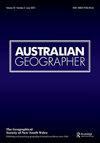Maurice T. Daly, 1939–2021
IF 2
2区 社会学
Q2 GEOGRAPHY
引用次数: 1
Abstract
Maurice (Maurie) Daly was a highly influential urban and economic geographer in an era when the ability to shape policy meant more to academic reputation than the metrics of h-Indexes. He coupled impressive scholarly credentials with the street-smart ability to identify and crystalise the nub of an issue in front of him. Maurie was proudly from the southern suburbs of Sydney, being born in Kogarah on 6th December 1939. Growing up in the rough and tumble of post-war suburban Sydney seemed to leave a profound imprint on his life, with his personality always staying true to those suburban values. He had brilliance for explaining complex ideas, and these were inevitably fashioned in language that was accessible to the common person. Generations of undergraduates understood the world better because of the clarity that Maurie could bring to the densest of subject matter on how financial or regulatory processes shaped flows of capital and hence the shape of our cities and regions. After being educated through the Catholic school system, Maurie attended the University of Sydney, from which he graduated with BA (Hons 1) in 1962. Never a person to waste time wondering what might come next, Maurie commenced a PhD immediately upon finishing Honours and at the same time moved to Newcastle with his new wife, Liz (they were married in 1964) to take a position at the Hunter Valley Research Foundation. Maurie completed his PhD in three years and on submission of his thesis moved to Canada where he was appointed Director of the Atlantic Provinces Economic Development program, afterwards returning to Australia to work on the Sydney Regional Plan, and then accepted a Rockefeller Foundation grant to work in Nigeria. Eventually Maurie returned to Australia to take up a post at Macquarie University, and in 1976 returned to his alma mater to become Professor of Geography. He held that position for 18 years until resigning in 1994. It was during his time at the University of Sydney that his major professional breakthroughs were achieved. Like others of his generation, Maurie was initially immersed in the quantitative revolution in Human Geography (he was a skilled mathematician) however, after a while was sufficiently astute to swim against the tide and recognise its shortcomings. As early as 1968, in an article exploring residential location decisions in Newcastle, NSW, he argued against the application of a formal model (rent theory) to explain the more complexly determined processes of how and why people made choices about where to live (Daly 1968). In 1973, he challenged another dominant formal approach (traditional location theory) in explaining the spatial distribution of factories in Australian cities, arguing instead that historical factors and the internal dynamics of firm-decision-makingMaurice T.Daly,1939–2021
莫里斯(毛里)戴利是一位极具影响力的城市和经济地理学家,在那个时代,制定政策的能力比h指数的指标更关乎学术声誉。他既有令人印象深刻的学术资历,又有敏锐的处世能力,能够识别并阐明摆在他面前的问题的核心。毛里出生于悉尼南郊,1939年12月6日生于科加拉。在战后悉尼郊区的混乱中长大似乎给他的生活留下了深刻的印记,他的个性始终忠于那些郊区的价值观。他善于解释复杂的思想,而这些思想不可避免地是用通俗易懂的语言表达出来的。一代又一代的大学生对世界有了更好的理解,因为毛里能够清晰地阐述金融或监管过程如何影响资本流动,从而塑造我们的城市和地区。在接受天主教学校系统的教育后,毛里进入悉尼大学,并于1962年以文学士(荣誉)毕业。毛里从来没有浪费时间去想接下来会发生什么,他在完成荣誉学位后立即开始攻读博士学位,同时和他的新婚妻子丽兹(他们于1964年结婚)搬到纽卡斯尔,在猎人谷研究基金会找到了一个职位。毛里在三年内完成了博士学位,并在提交论文后移居加拿大,在那里他被任命为大西洋省份经济发展项目主任,随后回到澳大利亚参与悉尼地区计划,然后接受洛克菲勒基金会的资助在尼日利亚工作。最后,毛里回到澳大利亚,在麦考瑞大学(Macquarie University)任职,并于1976年回到母校,成为地理学教授。他担任该职位长达18年,直到1994年辞职。正是在悉尼大学期间,他取得了重大的专业突破。像他那一代的其他人一样,毛里最初沉浸在人文地理学的定量革命中(他是一个熟练的数学家),然而,过了一段时间,他足够敏锐地逆流而上,并认识到它的缺点。早在1968年,在一篇探讨新南威尔士州纽卡斯尔住宅选址决策的文章中,他就反对应用正式模型(租金理论)来解释人们如何以及为什么选择住在哪里的更复杂的确定过程(Daly 1968)。1973年,他在解释澳大利亚城市工厂的空间分布时,挑战了另一种占主导地位的正式方法(传统区位理论),转而认为历史因素和企业决策的内部动力
本文章由计算机程序翻译,如有差异,请以英文原文为准。
求助全文
约1分钟内获得全文
求助全文
来源期刊

Australian Geographer
GEOGRAPHY-
CiteScore
4.10
自引率
8.30%
发文量
33
期刊介绍:
Australian Geographer was founded in 1928 and is the nation"s oldest geographical journal. It is a high standard, refereed general geography journal covering all aspects of the discipline, both human and physical. While papers concerning any aspect of geography are considered for publication, the journal focuses primarily on two areas of research: •Australia and its world region, including developments, issues and policies in Australia, the western Pacific, the Indian Ocean, Asia and Antarctica. •Environmental studies, particularly the biophysical environment and human interaction with it.
 求助内容:
求助内容: 应助结果提醒方式:
应助结果提醒方式:


